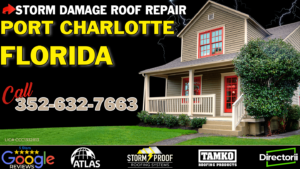After the Storm: Navigating the Verge of Ruin – A Comprehensive Guide to Repairing and Protecting Your Inverness Rooftop from Hurricane Havoc
Introduction
Hurricanes: Unleashing Nature’s Wrath As the calm ocean breeze turns into a roaring tempest, hurricanes emerge as one of the most devastating natural disasters known to humankind. These immense tropical cyclones, characterized by swirling winds and torrential rains, possess unparalleled destructive power that can leave entire communities in ruins.
The sheer force of hurricanes can wreak havoc on buildings, infrastructure, and lives in a matter of hours. Consequently, it is crucial for those residing in hurricane-prone areas to be well-prepared and knowledgeable about the necessary steps to take when disaster strikes.
Welcome to Inverness: Battling Mother Nature’s Fury Nestled along Florida’s picturesque Gulf Coast lies the vibrant town of Inverness.
With its breathtaking scenery and close-knit community, this idyllic haven seems like paradise on Earth. However, residing in such a picturesque locale comes at a cost – Inverness is no stranger to the wrath of hurricanes.
Located within a region frequented by these mighty storms due to its geographical positioning, this town has experienced its fair share of hurricane-related damage over the years. From battered roofs to collapsed structures, residents have learned firsthand just how crucial it is to be prepared and proactive when safeguarding their homes.
The Imperative of Swift Action: Mitigating Post-Hurricane Roof Damage When nature unleashes its fury upon your humble abode and leaves your roof battered and exposed, time becomes an adversary that cannot be ignored.
Taking immediate action after experiencing roof damage due to a hurricane is paramount for several reasons. Firstly, untreated roof damage can exacerbate existing structural weaknesses and compromise the integrity of your home further down the line.
Secondly, leaving your roof vulnerable exposes your living space to water intrusion during subsequent rainstorms or even mild showers – leading not only to potential water damage but also mold infestations. Addressing roof damage swiftly can significantly minimize repair costs and prevent further financial strain in already stressful times.
Brief overview of hurricanes and their destructive power
Unleashing Chaos: The Anatomy of a Hurricane Hurricanes, the monstrous offspring of warm ocean waters and atmospheric instability, are complex meteorological phenomena that can stretch hundreds of miles across. These colossal tropical cyclones are categorized according to the Saffir-Simpson Hurricane Wind Scale, which classifies them based on maximum sustained wind speeds.
Ranging from Category 1 (winds between 74-95 mph) to Category 5 (winds exceeding 157 mph), hurricanes possess the capacity to wreak havoc on even well-built structures. The Wrath of Wind: A Force to be Reckoned With
One of the most devastating aspects of hurricanes is the sheer force exerted by their powerful winds. Gusts reaching hurricane strength can easily tear shingles from roofs, send projectiles hurtling through the air, and uproot trees – turning them into formidable projectiles themselves.
The catastrophic combination of velocity and debris transforms these tempestuous winds into agents of destruction capable of dismantling even the sturdiest buildings. Deluge from Above: Relentless Rainfall
In addition to ferocious winds, hurricanes gift us with copious amounts of rainfall. As these tempests move across landmasses or hover over coastal regions, they unleash a deluge that can last for days on end.
This persistent downpour saturates soil, leading to flash floods that inundate homes and erode foundations. Furthermore, intense rainfall adds immense weight to roofs already under duress from high winds – increasing the likelihood of structural failure.
Introduction to Inverness: a town prone to hurricane damage
Enchanting Inverness: A Haven in Peril Inverness, with its enchanting charm and close proximity to the Gulf of Mexico, is a town that effortlessly captivates hearts.
However, its geographical location places it squarely within the path of hurricanes that regularly sweep across the state of Florida. This scenic town, nestled amidst nature’s splendor, has witnessed its fair share of devastation at the hands of these fearsome tropical cyclones.
From shattered windows to torn rooftops, Inverness residents have learned to face adversity head-on and rebuild their lives in the aftermath. Nature’s Playground turned Battlefield
Blessed with natural beauty abundant in lush vegetation and crystal-clear springs, Inverness’ allure is intimately tied to its surroundings. Unfortunately, this picturesque landscape also makes it vulnerable to hurricane damage.
Tall trees that dance gracefully during calm days transform into menacing projectiles during storms – posing immense threats to homes and delicate structures alike. The idyllic rivers flowing through Inverness can morph into raging torrents capable of swallowing bridges and roadways when torrential rainfall accompanies these tempestuous events.
Resilience through Unity: Inverness’ Spirit Despite enduring nature’s wrath time and again, what sets Inverness apart is its resilient community spirit.
Neighbors band together to support one another during challenging times, offering helping hands and comforting words when homes are destroyed or roofs are left tattered by powerful winds. The indomitable resilience found within these quaint streets transforms adversity into an opportunity for growth and strengthens the bond shared among residents who call Inverness their beloved abode.
Safety First: Assessing the Damage
Emphasize the need for personal safety before inspecting the roof
When faced with a hurricane-damaged roof, it is crucial to prioritize personal safety above all else. Before venturing onto your property to assess the damage, take a moment to evaluate potential hazards that may have been caused by the storm.
One of the primary dangers is downed power lines. These live wires can be extremely hazardous and must be treated with extreme caution.
Stay at least 30 feet away from any fallen electrical lines and immediately report them to local authorities. In addition to power lines, other hazards such as weakened structures, hanging debris, or unstable trees should also be noted and avoided.
It is wise to secure your surroundings by cordoning off unsafe areas until professionals can assess and repair them properly. By taking these precautions, you will ensure your own safety as well as that of others who may be present in and around your property during this challenging time.
Checking for downed power lines and other hazards
After establishing a safe environment, carefully examine your surroundings for any signs of danger resulting from the hurricane’s impact. Keep an eye out for downed power lines that can pose a significant threat even if they appear harmless at first glance. Fallen trees or branches leaning against power lines should also raise concerns about potential electrocution risks.
Moreover, consider other dangers such as gas leaks or exposed electrical systems that might have sustained damage during the storm. If you suspect any gas leakage or smell an unusual odor in the air, evacuate immediately and contact your local utility provider at once from a safe location.
Wearing appropriate protective gear (hard hat, gloves, sturdy shoes)
Before assessing roof damage caused by a hurricane, it is essential to equip yourself with suitable protective gear to minimize risks associated with potential hazards. A hard hat will safeguard your head against falling debris, while sturdy gloves will protect your hands from sharp objects and potential contamination.
Wearing sturdy, slip-resistant shoes is equally important to ensure stability and prevent accidents while walking on damaged surfaces. Additionally, it is advisable to wear long-sleeved shirts and pants to shield your skin from cuts, scratches, or contact with hazardous materials like broken glass or exposed nails.
Conducting a thorough assessment of the roof damage
Once you have taken the necessary safety precautions and equipped yourself with appropriate protective gear, it is time to meticulously assess the damage inflicted upon your roof by the hurricane’s fury. Start by examining visible signs of damage such as missing shingles or tiles, displaced flashing, or sagging sections.
Carefully inspect for leaks or any indications of water penetration inside your home. Water stains on walls or ceilings can often be a telltale sign that there may be more extensive damage hidden beneath the surface.
It is crucial to document everything you find during this assessment process as visual evidence will support insurance claims and aid in effective repairs. Using a camera or smartphone, capture detailed photographs or videos of all damaged areas from various angles.
These visual records will serve as valuable documentation for insurance adjusters and contractors when estimating repair costs and determining the extent of necessary repairs. By following these safety guidelines and conducting a thorough evaluation of the roof damage caused by a hurricane, you lay a solid foundation for properly addressing restoration efforts effectively and efficiently.
Temporary Fixes: Protecting Your Home from Further Damage
Covering exposed areas with tarps or plastic sheets
When your roof is damaged after a hurricane, one of the first steps you should take is covering any exposed areas to prevent further water intrusion and potential structural damage. Tarps or plastic sheets can serve as temporary covers until permanent repairs can be made.
It’s crucial to select an appropriate size tarp that fully covers the damaged area and extends beyond it. Secure the tarp tightly using ropes or bungee cords, ensuring that it is stretched without any sagging.
This will help prevent wind from getting underneath and causing additional damage. Be sure to affix the edges of the tarp securely to prevent it from being blown away during subsequent storms.
Explaining how to secure temporary covers effectively
Securing temporary covers – such as tarps or plastic sheets – in a proper manner is essential for their effectiveness in protecting your home from further damage. Begin by choosing sturdy materials that are specifically designed for this purpose, ensuring they are large enough to fully cover the affected area.
To secure the cover, start by installing furring strips around the perimeter of the damaged section. Next, carefully place the tarp over the damaged area, allowing it to extend beyond all sides of the repair zone by at least two feet.
Use nails or screws to attach one edge of each furring strip through reinforced grommets on one side of the tarp, while leaving enough slack for tension adjustments if needed. Repeat this process for each side, evenly distributing attachment points along furring strips as necessary.
Preventing water intrusion and additional structural damage
Water intrusion resulting from a damaged roof can exacerbate structural issues and cause further harm to your home’s interior. By promptly covering exposed areas and securing them properly with tarps or plastic sheets, you can significantly reduce the risk of additional water damage.
In addition to covering the damaged areas, it is crucial to clear debris from your gutters and downspouts. Clogged gutters prevent proper drainage during heavy rainfall, causing water to accumulate on your roof.
This excess water adds unnecessary weight and increases the likelihood of leaks and further structural damage. By ensuring that water properly drains through the gutter system, you can mitigate these risks and protect your home from potential harm.
Conclusion
In moments of devastation caused by a hurricane’s aftermath, taking swift action to protect your home is vital. Temporary fixes such as covering exposed areas with tarps or plastic sheets provide immediate relief by preventing further damage from wind and rain.
Securing these temporary covers effectively ensures their stability during subsequent storms. Additionally, ensuring proper drainage through clearing debris from gutters and downspouts is essential for safeguarding your home against additional water intrusion and potential structural harm.
Remember, even temporary measures play a crucial role in minimizing post-hurricane damage while awaiting permanent repairs. By addressing these issues promptly and effectively, you take important steps towards restoring safety and peace of mind after a hurricane’s destructive impact.



